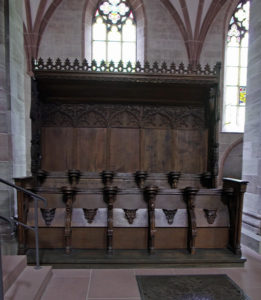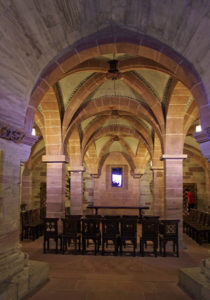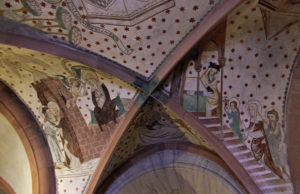This lovely red sandstone building with its decorative red, green and grey tile roof is one of the highlights of the old town as seen from the River Rhine.
The building dates from the early C11th and the north transept is the best Romanesque facade in Switzerland, with its doorway with the tympanum of the last Judgement. Beneath is the parable of the wise and foolish virgins. On either side are the four apostles with the six Works of Mercy. The bronze door is C19th.
The nave dates from around 1220, although part of the building was destroyed by an earthquake in 1366 and was rebuilt on the same floor plan in the Gothic style. The difference in stonework can be seen on the north west tower with its statue of St George killing the dragon. The building was finally completed around 1500 with the finials on top of the two west towers.
Unusually, the cathedral has two cloisters, built in the C15th. The larger one has walls lined with monuments. The Mary Magdalene Chapel is off the east wall of the cloisters and was used for burials after the reformation and the walls are lined with splendid memorials. To the east and separated by what is described as a ‘hall’, is a smaller cloister
Entry to the cathedral is through the small door adjacent to the south west tower. This leads past the shop (not very good English) and into the nave. The nave and inner aisles are Romanesque. The outer aisles are Gothic. The choir was rebuilt in the Gothic style after the earthquake. When I visited there was an exhibition about Erasmus in the choir with strictly no photography.
It feels a big and rather bare church and is quite dark inside. The thing all the guide books mention is climbing the towers for views across Basel and the memorial to Erasmus of Rotterdam on one of the pillars in the north aisle. To be honest, this is a bit boring, just being a large, plain carved memorial. To me, the most impressive bits were the Romanesque north transept with its lovely rose window with C19th stained glass and the stained glass windows in clerestory above the chancel are equally as impressive.
Running these a very close second, were the paintings on the ceiling of the crypt which date from 1400. These show the life of the Virgin and the childhood of Christ. The crypt itself is also impressive and don’t miss the stone sarcophagus of Bishop Rudolph in a side apse, who,was reportedly killed 917AD during invasion of Hungary.
The cathedral is open daily from 10-5 and entry is free. There is more information and pictures “here.”:http://wasleys.org.uk/eleanor/otherholidays/rhine/e_basel/cathedral/index.html










